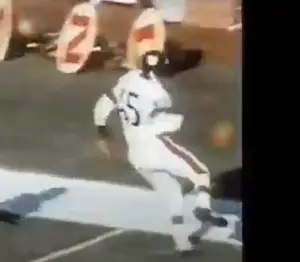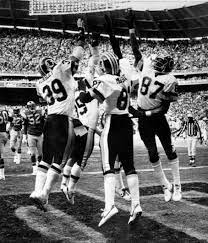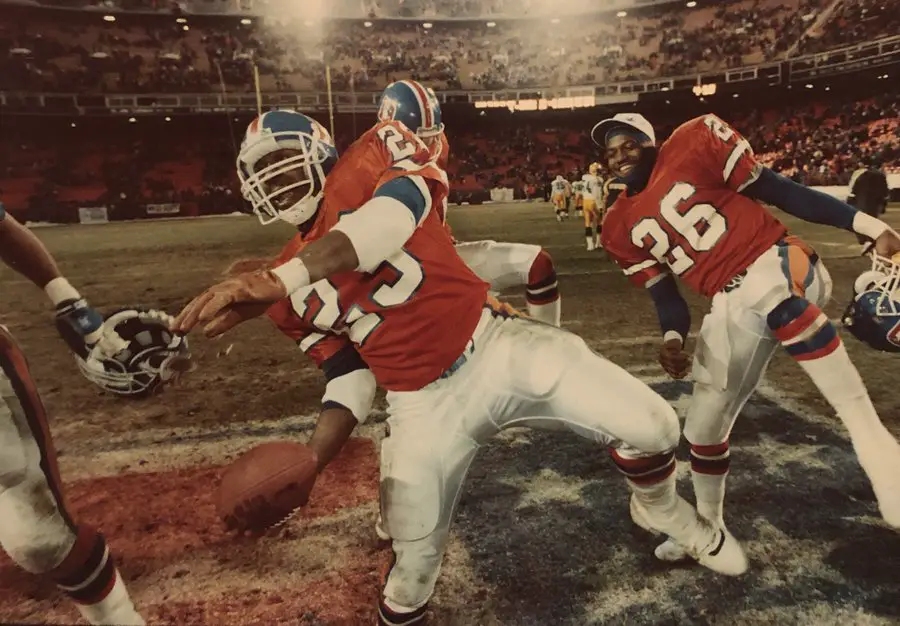The history of controversial touchdown celebrations will be discussed today – we will boot scootin’ boogie our way through the dances that set the stage for our touchdown tangos today.
In the recently dropped Homicide bride series, Fred Lane’s infamous crotch grab touchdown celebration inspired the writing of this article. RIP Fred Lane – we wish we could have seen more touchdown celebrations from you.
The very first touchdown celebration
Like most “firsts” in history, there is no clear consensus on which touchdown celebration came first and what counted as a celebration. We will appreciate all of our frolicking football forefathers. In this case, multiple people can be first.
The Spike – October 17th, 1965

Homer Jones is often credited with the first touchdown celebration. The Spike (pictured above, if you squint) came about when Homer was about to toss his game ball into the crowd post-touchdown but realized he would earn a harsh fine, so instead, he spiked it. The fans loved it, and Jones did the spike for the rest of his career.
Jones said at age 70 that he wished he had never started the touchdown celebration trend due to all of the dancing debauchery he has seen since.
The Accelerated High Step – 1969
Settling a bet with video. Elmo Wright, 1970
The first person with an end zone celebration dance.
(Yes,. Homer Jones was the first to spike the ball instead of throwing it in the stands.#NFL #ElmoWright #HomerJones pic.twitter.com/1m2Ac3LlZ9— Derrick Pearson (@derrickpearson) April 8, 2020
Elmo Wright debuted his dance in 1969 as a University of Houston Cougar. He brought his talents to the NFL in 1971, and we are all the better for it. Wright recalls that refs didn’t care for the spike; they always had to run for the ball. Friends encouraged him to find an alternative, and he did one TD when he was high-stepping his way to the touchdown. He decided he should continue high stepping both faster and higher – that was how the first touchdown dance was born. Elmo’s dance was the only touchdown tango with no official name.
Elmo expressed his joy through dance; they were always spontaneous reactions to the moment. His coach ignored his moves as long as he was in the end zone – Wright felt supported to be both entertaining and talented. Elmo’s high steps hijacked the fan’s attention, and his popularity grew even with his stats going down.
Elmo faced racism when he danced – it was during the height of the Civil Rights era, and tensions were high. Southern states were less receptive to his celebrations than other locations. Individuality also wasn’t appreciated in the game of football. Wright’s dances drew attention to just him, much to the chagrin of some fans. Elmo has an incredible sense of humor about it all and decided to dance his way through the discrimination – he enjoyed being an entertainer.
Funky Chicken – 1974
Super B-Day to Billy "White Shoes" Johnson, who elevated touchdown celebrations to an art form. #FunkyChicken pic.twitter.com/jqQVtRFhtp
— Super 70s Sports (@Super70sSports) January 27, 2016
Billy “White Shoes” Johnson was known for two things: his blindingly white shoes and his Funky Chicken touchdown dance. Johnson was inspired by the 1969 song “Do the Funky Chicken.” Billy loved the dance, the fans loved the dance, and the NFL did not love the dance. His coach told him he didn’t care what he did as long as he got the TDs.
The dance was so appreciated by most that opposing players would call him the night before the game verifying he would do the dance. Billy was always respectful with his moves – he would avoid any hint of taunting by distancing himself from the opposing team before he started any celebrations. He, like everyone else on this list, would get fined anyway.
Billy Johnson is a better sport than Homer Jones when he looks back on his dances. Watch a video of him teaching Peyton Manning the Funky Chicken in 2019 here. It’s clear neither football great has the best knee joint mobility these days. Same, guys, same.
Two-stepping through the 80’s
The Fun Bunch – 1982

The Fun Bunch formed the first group touchdown celebration in the NFL. The celebration started out as a touchdown tribute for an injured teammate, and became a cultural sensation. Even when their teammate returned the following year, the Fun Bunch couldn’t stop – it was too popular at that point. Comedians were doing it, school aged children were doing it, you’re parents probably did it.
Some players didn’t love it – Lyle Alzado predicted, “it’s going to be a bleeping disco.” That was just a little roid rage. The Fun Bunch became a verb. Don Shula, a coach who appeared to have a flair for the dramatics, claimed that the dance move was a “potential bombshell” after he got what was described as “Fun Bunched.”
One group that wasn’t open to being Fun Bunched was the NFL higher-ups. In 1984, dances were added to the taunting rule. No prolonged, excessive, or premeditated celebrations would be allowed by individuals or groups. Every moment of joy would earn the team a 5-yard penalty.
Ickey Shuffle – 1989
Unlike Wood’s high-stepping, funky chicken dancing predecessors, the Ickey Shuffle required practice and fine-tuning. Woods got his first 2 NFL TDs in week 4 of his rookie year, with his mother in attendance. The combination gave him happy feet. Teammates (and his mother) were critical, asking him what he was doing and calling the shuffle prototype “wack.” It was also called “stiff-legged” by news services. With the help of the same critical teammate, Woods was able to perfect his shuffle. A choreography was developed, and another cultural sensation was born.
Once again, the NFL got cranky. They fined Ickey for his jubilance. The team and Ickey loved his dance so much that they would clear a large enough area on the sideline for him to shuffle to his heart’s content. The NFL tried to fine him for that too but had to backtrack on their bull crap. The NFL wouldn’t stop him, but his knee injuries would.
Elbert “Ickey” Woods is still giving out dance lessons to this day. Yes, Woods!
When touchdown celebrations went wrong
Some opposing players would intentionally get in the middle of the Fun Bunch to thwart their touchdown fun and instigate fights.
Most of the conflict came from a different kind of celebration – the sack dance. However, the two dances were often combined to justify rules limiting what was usually good, clean fun.

Angry pants Seattle Seahawks Ron Mattes chop-blocked Bruce Smith after Bruce did a little jig post-sack.
Mark Gastineau instigated a brawl of monumental proportions when he did what can be loosely interpreted as a dance post-sack. The LA Rams took immediate offense to Mark’s moves and a brawl that lasted for minutes, with most players getting in on the action.
Honorable mention
Although the Super Bowl Shuffle was not technically a touchdown celebration, it was a celebration and also the most epic music video of all time.

For more of my football history gems, look here and here.
If you want an article with more groovy gyrations of the 90’s, such as the Dirty Bird sound off below!


